Here's some more benchmarks for Docker based memcached server versus host native memcached server using Twemperf benchmark tool https://github.com/twitter/twemperf with 5000 connections and 20k connection rate
Connect time overhead for docker based memcached seems to agree with above whitepaper at roughly twice native speed.
Twemperf Docker Memcached
Connection rate: 9817.9 conn/s
Connection time [ms]: avg 341.1 min 73.7 max 396.2 stddev 52.11
Connect time [ms]: avg 55.0 min 1.1 max 103.1 stddev 28.14
Request rate: 83942.7 req/s (0.0 ms/req)
Request size [B]: avg 129.0 min 129.0 max 129.0 stddev 0.00
Response rate: 83942.7 rsp/s (0.0 ms/rsp)
Response size [B]: avg 8.0 min 8.0 max 8.0 stddev 0.00
Response time [ms]: avg 28.6 min 1.2 max 65.0 stddev 0.01
Response time [ms]: p25 24.0 p50 27.0 p75 29.0
Response time [ms]: p95 58.0 p99 62.0 p999 65.0
Twemperf Centmin Mod Memcached
Connection rate: 11419.3 conn/s
Connection time [ms]: avg 200.5 min 0.6 max 263.2 stddev 73.85
Connect time [ms]: avg 26.2 min 0.0 max 53.5 stddev 14.59
Request rate: 114192.6 req/s (0.0 ms/req)
Request size [B]: avg 129.0 min 129.0 max 129.0 stddev 0.00
Response rate: 114192.6 rsp/s (0.0 ms/rsp)
Response size [B]: avg 8.0 min 8.0 max 8.0 stddev 0.00
Response time [ms]: avg 17.4 min 0.0 max 28.8 stddev 0.01
Response time [ms]: p25 12.0 p50 20.0 p75 23.0
Response time [ms]: p95 28.0 p99 28.0 p999 29.0
Here's bencmarks using memtier benchmark tool
memtier_benchmark docker Memcached
4 Threads
50 Connections per thread
10000 Requests per thread
Type Ops/sec Hits/sec Misses/sec Latency KB/sec
------------------------------------------------------------------------
Sets 16821.99 --- --- 1.12600 2271.79
Gets 168035.07 159636.00 8399.07 1.12000 23884.00
Totals 184857.06 159636.00 8399.07 1.12100 26155.79
memtier_benchmark Centmin Mod Memcached
4 Threads
50 Connections per thread
10000 Requests per thread
Type Ops/sec Hits/sec Misses/sec Latency KB/sec
------------------------------------------------------------------------
Sets 28468.13 --- --- 0.62300 3844.59
Gets 284368.51 266547.14 17821.36 0.62200 39964.31
Totals 312836.64 266547.14 17821.36 0.62200 43808.90




